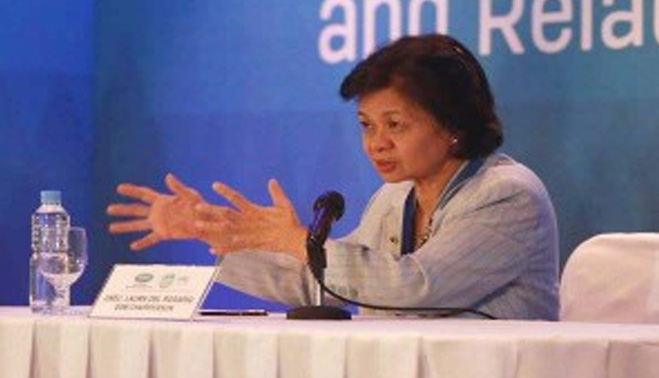![]() Home > Philippines
Home > Philippines
PH Needs To ‘Mend Fences’ With China

Ambassador Laura del Rosario / Photo courtesy of APEC2015 via Twitter
![]() June 27th, 2016 | 08:49 AM |
June 27th, 2016 | 08:49 AM | ![]() 1422 views
1422 views
MANILA, PHILIPPINES
The Philippines needs to do a lot of “mending fences” with China once the Netherlands-based Permanent Court of Arbitration (PCA) issues anytime now its ruling on the case filed by Manila with respect to the dispute with Beijing over maritime jurisdiction in the West Philippine Sea/South China Sea.
This was suggested by Foreign Affairs Undersecretary for International Economic Relations Laura del Rosario during a Foreign Correspondents Association of the Philippines forum held recently in Makati City as she noted the bitterness that China continues to feel after the Philippines instituted arbitral proceedings in 2013.
“China questions why we filed that arbitration,” said Del Rosario. “Somehow they cannot accept it.”
“We need to do a lot of reaching out, to save our friendship with China and not to embarrass them,” she added.
As this developed, the second United States air contingent temporarily stationed at Clark Air Base in Pampanga officially began its daily operations that include training with Armed Forces of the Philippines (AFP) pilots and providing support for routine operational missions that enhance regional maritime domain awareness.
EXCITING TIME FOR DIPLOMACY
One possible way to iron out the differences and erase the animosity, according to Del Rosario is for the Philippines to initiate bilateral dialogue with China.
Del Rosario said it is imperative that negotiations must resume between the two parties once the PCA has issued a ruling in order to put strained relationships in order.
“This is an exciting time for diplomacy with China,” she noted.
Supreme Court Senior Associate Justice Antonio Carpio agrees that there has to be “face-saving” for everyone involved in the case.
The best way for the Philippines to swiftly resume close relations with China is to undertake diplomatic negotiations and the right time for Manila to go bilateral is after the PCA ruling.
“Personally, the right time to go bilateral is after the ruling,” said Justice Carpio during the same forum.
This is precisely why the Philippines’ decision to seek adjudication from the PCA with regards to its South China Sea territorial dispute with China does not mean failure of diplomacy.
“Once a ruling has been issued, negotiation must continue,” Carpio stressed.
Arbitration commenced on January 22, 2013 when the Philippines served China with a Notification and Statement of Claim with respect to the South China Sea dispute.
However, on February 19, 2013, China presented the Philippines with a diplomatic note in which it described “the Position of China on the South China Sea issues,” and rejected and returned the Philippines’ Notification.
Until now, just a few days before the PCA hands down its ruling, the Chinese government continues to adhere to the position of neither accepting nor participating in these arbitral proceedings.
China said its right to freely choose the means of dispute settlement must be fully respected, and its rejection of and non-participation in the South China Sea arbitration is solidly grounded on international law.
China holds that negotiations are always the most direct, effective, and universally used means for peaceful settlement of international disputes.
COMBAT POWER
An earlier statement issued by the US Seventh Fleet indicated that, “in addition to bilateral training missions, Growler aircraft will support routine operations that enhance regional maritime domain awareness and assure access to the air and maritime domains in accordance with international law.”
VAQ-138’s presence in the country is part of a US Air Contingent established by the US Pacific Command in April with the approval of the Philippine government and planned and executed by the PACAF
“Maintaining a joint aerial presence throughout the Indo-Asia-Pacific is vital to ensuring regional stability,” said Brig. Gen. Dirk Smith, PACAF Director of Air and Cyberspace Operations.
“By enabling this Air Contingent in the Philippines, we are securing excellent opportunities for soldiers, sailors, airmen and Marines to hone their capabilities and strengthen ties with their counterparts in the Philippines,” he added.
US Navy Cdr. Aaron Tabor, the VAQ-138 commanding officer, said the unit’s deployment to Clark is an example of how the US and the Philippines are committed to maintaining credible combat power throughout the Indo-Asia-Pacific region.
“Our presence here demonstrates our ability to work effectively with regional allies,” Tabor said, adding: “We are building upon the strategic and lasting partnership between the US and the Philippines.”
US officials have emphasized that the detachment “is only here for a time period agreed upon by the Philippines and US governments to conduct its operations and then will depart.”
An initial US Air Contingent composed of about 200 American pilots and crew members, as well as five A-10C Thunderbolt II ground attack aircraft and three HH-60G Pave Hawk combat search and rescue (CSAR) helicopters stayed in the country for two more weeks after the “Balikatan” Exercises in April “to continue joint training, conduct flight operations in the area, including the South China Sea, and lay the foundation for joint air patrols to complement ongoing maritime patrols.”
They flew out of the country after a fourth and final mission April 28 in international waters west of the Philippines.
Source:
courtesy of MANILA BULLETIN
by Elena L. Aben And Roy C. Mabasa
If you have any stories or news that you would like to share with the global online community, please feel free to share it with us by contacting us directly at [email protected]